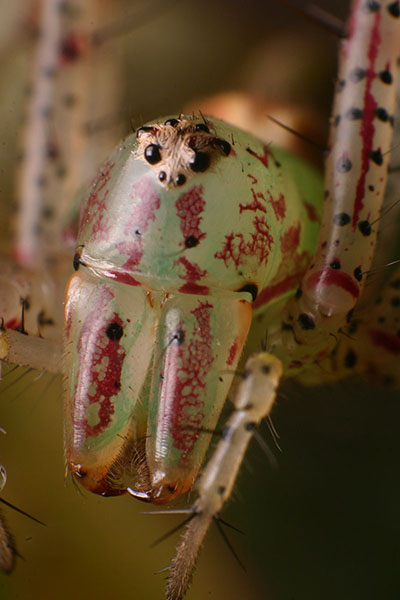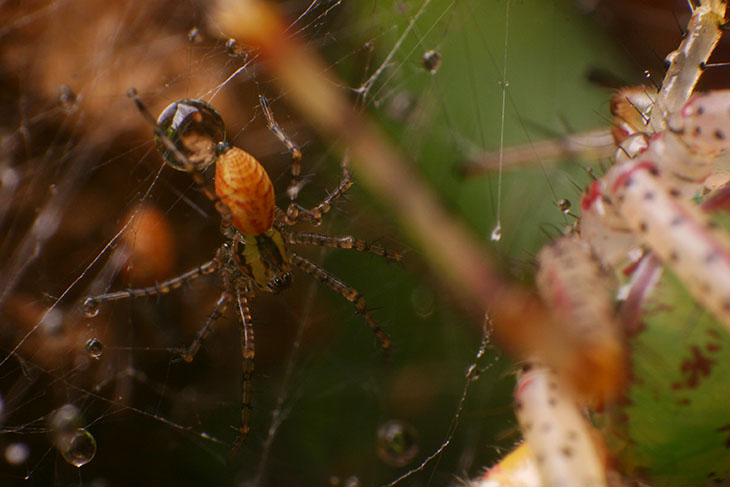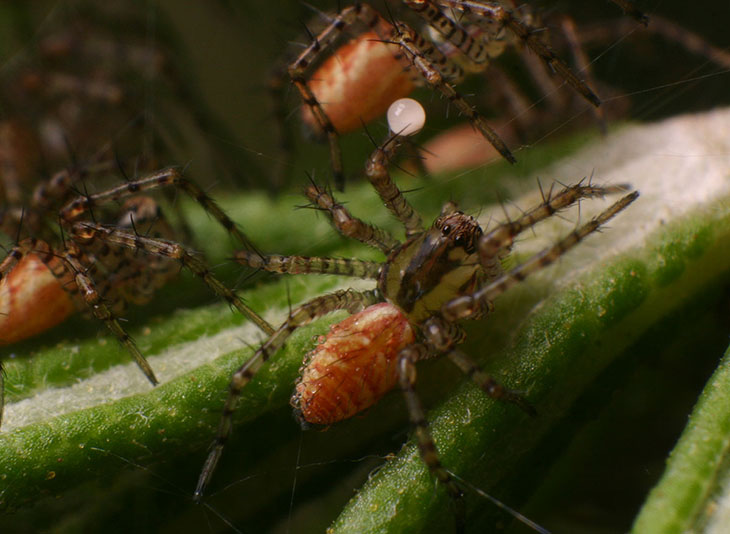I’m sorry, it’s what I’m finding to photograph.

So about a month ago I mentioned that the green lynx spiders (Peucetia viridans) that I’d been observing had all made egg sacs; one on the dog fennel plants, one on the butterfly bush, and one on the rosemary bush. They have all since hatched, and I’ve been watching the new spiderlings until they cast away soon – if I get lucky, I’ll get some pics of this occurring, but I’m not counting on it. At macro magnifications I expect they’ll flash out of focus almost instantly.

In the meantime, I’m going out and trying for interesting compositions and closeups, which can be problematic. The newborns tend to stay clustered, head inwards for protection, and helicopter mom advances quite aggressively whenever I loom too close or the softbox starts bumping against the outer web strands. In the image above from the dog fennel, you can see how the egg sac was placed deep in protective foliage, and the out-of-focus blur to the right is mama in the foreground.
 In fact, this has allowed me to get some better portraits (for a given definition of “better,” anyway) of the adults, who previously were too shy to allow really close approaches, but in the throes of protective motherhood they practically climb onto the camera. This is the same specimen as the one at top, and the one seen in this post – note how much color change has occurred. The one on the rosemary bush, however, disappeared on the same day that one of the pregnant mantises was seen on the same bush, so it’s quite likely she provided protein for mantis eggs and now her offspring, hatched after her disappearance, are fending for themselves. Since they’re in quite good cover and practically invisible, they don’t appear to be doing too badly so far, but I haven’t tried counting the clutches to know if the numbers are dwindling.
In fact, this has allowed me to get some better portraits (for a given definition of “better,” anyway) of the adults, who previously were too shy to allow really close approaches, but in the throes of protective motherhood they practically climb onto the camera. This is the same specimen as the one at top, and the one seen in this post – note how much color change has occurred. The one on the rosemary bush, however, disappeared on the same day that one of the pregnant mantises was seen on the same bush, so it’s quite likely she provided protein for mantis eggs and now her offspring, hatched after her disappearance, are fending for themselves. Since they’re in quite good cover and practically invisible, they don’t appear to be doing too badly so far, but I haven’t tried counting the clutches to know if the numbers are dwindling.
As impressive as this visage might be, know that the body length of the adult is just 17mm (about 3/4 inch,) and the face you’re seeing here is roughly 6mm long, less than the width of a pencil – getting those measurements meant that she did indeed take a shot at the calipers, which did not appear to notice. I’m pleased to get those little brown fangs, because they really can’t be seen in any normal circumstances, but also note the sensitive hairs on the inside edges of the chelicerae near the fangs, which help tell the spider what’s going on with their prey.
Here’s another shot from the butterfly bush, with mom running interference:

It was a misty day when I took it, thus the water drops in the web. The smaller orange blob in the background is a sibling, but the overall brown mass is the egg sac, still serving as home base though the young do not re-enter it at all.
My favorite image, however, remains this one, from the orphans on the rosemary:

The overnight dew on the abdomen is a delightful detail, as is the safety ‘dragline’ of webbing extending from the spinnerets, which is virtually always present for spiders yet rarely visible – in these cases, it helps contribute to the cocoon of webbing that protects the young and alerts mom that there’s a strange dog in the yard. To the best of my knowledge, the white sphere is pollen – but I suppose it could be a crystal ball, and I was interrupting their mother telling them everything was wonderful in The Beyond and that heaven was filled with fat, slow flies.




















































